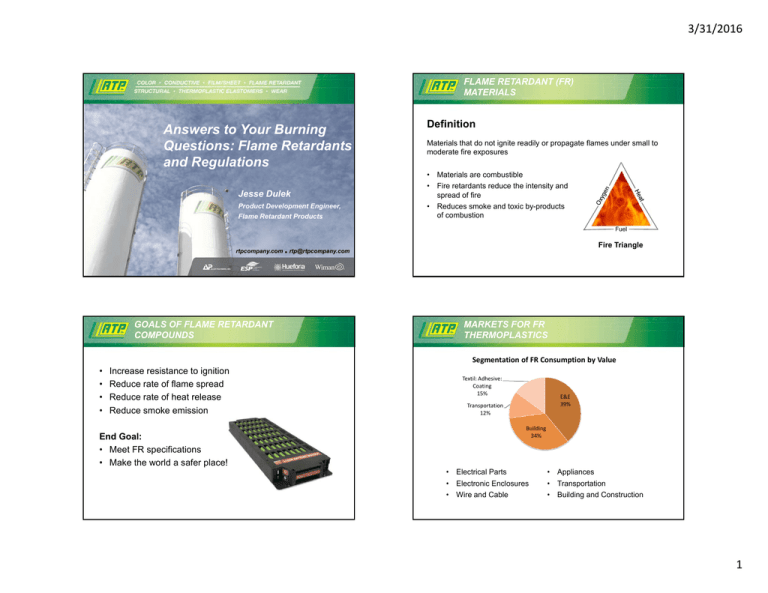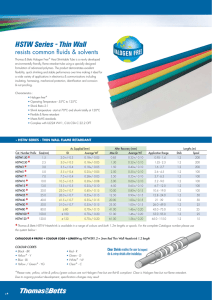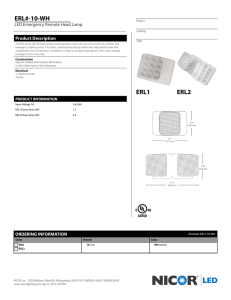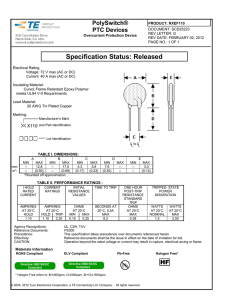Answers to Your Burning Questions: Flame
advertisement

3/31/2016 FLAME RETARDANT (FR) MATERIALS Answers to Your Burning Questions: Flame Retardants and Regulations Jesse Dulek Product Development Engineer, Flame Retardant Products Definition Materials that do not ignite readily or propagate flames under small to moderate fire exposures • Materials are combustible • Fire retardants reduce the intensity and spread of fire • Reduces smoke and toxic by-products of combustion Fuel rtpcompany.com GOALS OF FLAME RETARDANT COMPOUNDS Fire Triangle rtp@rtpcompany.com MARKETS FOR FR THERMOPLASTICS Segmentation of FR Consumption by Value • • • • Increase resistance to ignition Reduce rate of flame spread Reduce rate of heat release Reduce smoke emission End Goal: • Meet FR specifications • Make the world a safer place! Textil: Adhesive: Coating 15% E&E 39% Transportation 12% Building 34% • Electrical Parts • Electronic Enclosures • Wire and Cable • Appliances • Transportation • Building and Construction 1 3/31/2016 THERMOPLASTIC RESIN FLAMMABILITY OVERVIEW • Thermoplastic Flammability • Regulatory Landscape • • • • • • • Testing Standards • Case studies • Hospital Cleaner Resistant Technology CHALLENGES OF FLAME RETARDING PLASTICS Inherently Flame Resistant Flammable • Flame Retardant Additive Chemistries and Mechanisms Polyolefins Nylons Polycarbonate Polyesters Styrenics TPEs • • • • • Polysulfones Polyphenylene Sulfide Polyetheretherketone Polyetherimide Flouropolymers COMMON TYPES OF FR ADDITIVES Limiting Oxygen Index Halogenated FR’s Flame Retardant Additive Usage, 2011 Acetal • Brominated • Chlorinated Cotton PE PP Other 6% Bromine 22% ABS PMMA SAN Halogen Free FR’s PET PBT Nylon 6/6 • Metal hydroxides • Phosphorous Based • Melamine Based PC PSU TPI PVDF PVC Inorganics 44% Phosphorus 16% Chlorine 12% PTFE 0 10 20 30 40 50 60 70 80 90 100 LOI % 2 3/31/2016 HALOGENATED FR MECHANISM • Halogenated technology inhibits the chemical reaction in the gas/vapor phase • Various molecules that efficiently get large amounts of free radicals to the gas phase Additive Type • Higher Halogen Content • Lower Loadings • High Thermal Stability Phosphorous • Various forms • Contributes to the condensed phase char formation Polymeric Type HALOGEN VS. HALOGEN-FREE Halogen Free • Lower Cost • Evolving Economics • Better Processing • Improved Processability • Better Efficiency • Wide Variety of Products • Better Physical Properties • Low Smoke • Lower Toxicity • Less Corrosive Hydrated Minerals • Produce water during combustion process, dilute flammable vapors Melamine Cyanurate • Endothermic decomposition • Physical removal of flame from surface • Insulative char formation • Melt Blendable • Less effect on physical properties • Enhanced Flow Halogenated flame retardants are compatible in most resin systems with the exception of Acetal Halogenated NON-HALOGEN MECHANISMS Resin Systems Polyolefins, Polyamides, Polyesters, Polycarbonate and alloys Polyolefins, Polyamides Polyamides, used as a synergist for other Phosphorous technologies CHOOSING A FR SYSTEM How do we decide which FR mechanism to use? • Resins System • FR Specification • Part Function • Fillers/Additives • Lower Specific Gravity • Regulatory Concerns • Halogen, RoHS, etc 3 3/31/2016 OVERVIEW ROHS DIRECTIVE • Restriction of Hazardous Substances (RoHS) • Thermoplastic Flammability • Flame Retardant Additive Chemistries and Mechanisms • Regulatory Landscape • Testing Standards • Case studies • EU Directive in effect as of July 2006 • Banned Substances • • • • • Lead (Pb) Mercury (Hg) Cadmium (Cd) Hexavalent Chromium (CrVI) Polybrominated Biphenyls (PBB) and Polybrominated Diphenyl Ethers (PBDE) • Flame Retardants and Pigments • Hospital Cleaner Resistant Technology Does not need to be Halogen Free! IMPACT OF ROHS How does RoHS compliance affect material selection? • Drop in replacements available • Identical Properties • • Physical, Flow, Heat Resistance, Processability Cost Premium EVOLUTION OF HALOGEN-FREE TECHNOLOGIES • More “self-policing”/customer driven bans • New FR standards • Green Movement • More Effective/Economical FR Chemicals • Increased Performance • Competition in the Market 4 3/31/2016 HALOGEN RESTRICTIONS IMPACT OF HALOGEN-FREE • Resin Limitations • OEM Driven Ban on Halogenated Chemicals • HP, DELL, IBM etc. • Physical Properties • Eco Labels • Strength/Impact • Flow • Blue Angel, White Swan, Ecolabel etc. • Heat Resistance • Resin Dependent • Flammability • Cost • Reduction in Specific Gravity 30% GF NYLON 6/6 Mechanical Properties Tensile Strength, psi OVERVIEW RTP 205 FR RTP 205 FR Halogen Free 21000 19500 Tensile Modulus, psi E6 1.65 1.45 Tensile Elongation, % 2-4% 2-4% Flexural Strength, psi 33000 31500 1.55 1.45 2 1.8 Flexural Modulus, psi E6 Impact Notched, ft-lb/in Impact Un-notched, ft-lb/in 16 16 HDT @ 264 psi 470 470 Specific Gravity Flammability 1.66 1.41 V-0 @ 1/32 V-0 @ 1/32 • Thermoplastic Flammability • Flame Retardant Additive Chemistries and Mechanisms • Regulatory Landscape • Testing Standards • Case studies • Hospital Cleaner Resistant Technology 5 3/31/2016 INDUSTRY AND MARKET DRIVEN Electrical and Electronics (E&E) RTP COMPANY UL CERTIFICATION RTP Company has 600+ UL Yellowcards • Continuous expansion of UL listed products • UL 94 •V, 5V, HB UL Certified Laboratory under Client Test Data Program (CTDP) • UL 746 • Short term properties to UL94 • Long term thermal aging (RTI) •HAI, HWI, CTI RTP Company offers custom UL certifications to achieve full commercialization • Quick turnaround • Compress your Time to Market! UL94 - HB UL94 - VB Horizontal burning test for HB classification Classification Criteria 100 + 1mm V-0 V-1 V-2 Number of bar specimens 5 5 5 Maximum flame time per specimen per flame application, sec 10 30 30 25 + 1mm Specimen Specimen 10 + 1mm Wire Gauze Wire Gauze Classification Criterion 3.0 mm to 13.0 mm thickness • slower than 40 mm/minute or… • combustion ceases prematurely < 3.0 mm thickness • slower than 75 mm/minute or… • combustion ceases prematurely ** In general most thermoplastics meet this criteria** 20 + 1 mm 10 + 1 mm Burner 300 + 10 mm Maximum total flame time 5 specimens, 2 ignitions, sec 50 250 250 Specimen drips, ignites cotton NO NO YES Maximum afterglow time per specimen, sec 30 60 60 Burn to holding clamp NO NO NO Cotton 6 mm max. Thickness dependent ratings 6 3/31/2016 UL94 VERTICAL BURN DEMO Flame Retardant – V-0 Non- Flame Retardant – No Rating AEROSPACE FAR 25.853 • Flammability: • 15-Second Horizontal Burn • 12-Second Vertical Burn • 60-Second Vertical Burn OEM Driven Requirements • Toxic Gas Emission: • Varies by OEM • ABD0031 or BSS 7239 • Smoke Density: • Ds@4min <200 • ABD0031 or BSS 7238 or ASTM E-662 • Ohio State University Heat Release: • Calorimetry Test Measures Peak and Total Heat Release • <100/100, <65/65, & <55/55 are common Requirements vary by part size and location RECAP BUILDING / INDUSTRIAL • Requirements focus on: Designing for an FR application • Low Smoke, Heat Release, Burn Rate, Flame Spread • • Various standard that apply: Regulatory Landscape • RoHS, Halogen Restrictions • UL2043, UL723/ASTM E84, ASTM E1354, NFPA 701, FM 4996, CAL TB133 • Specifications • UL94, FAR, ASTM, etc. • Part Function • Performance Requirements, Application Environment, etc. • Economics • Price is a Property Applications: Wall coverings, Furniture, Plenum, Pallets, Storage systems, Roofing, Floor coverings, Ventilation 7 3/31/2016 OVERVIEW FR MEETS TRANSPARENCY • Thermoplastic Flammability • Flame Retardant Additive Chemistries and Mechanisms • Regulatory Landscape LED Lens Cover • Testing Standards Market: Consumer Problem: UL 94 V-0, High Light Transmission, UV, Light Diffusion, RoHS Compliance Solution: PC – Transparent, Flame retardant, Specialty pigment package Benefits: Provided ample diffusion of high powered LED lights with a proprietary pigment technology while achieving the required flame performance • Case studies • Hospital Cleaner Resistant Technology FR MEETS OUTDOORS / UV Marine Connector FR BREAKS THROUGH THE CEILING Speaker Unit Market: Consumer Problem: Strength/impact, UV resistance, specialty color, UL94 V-0, F1 Solution: PC/PBT – Glass reinforced, UV stabilized, Flame Retardant Benefits: Product was able to pass the required drop impact testing and stringent UL outdoor and flammability ratings Market: Industrial Problem: Plenum location, UL 2043, UL94 5VA, Rigidity Solution: Polypropylene – Glass fiber reinforced, Halogen free Flame Retardant Benefits: Provided structural requirements needed for function and stringent UL flame resistance 8 3/31/2016 OVERVIEW PROBLEM STATEMENT Hospital Acquired Infections • Thermoplastic Flammability • Flame Retardant Additive Chemistries and Mechanisms • Regulatory Landscape • Testing Standards • 2,000,000 new cases per year (USA) • 100,000 deaths per year (USA) • $11 Billion additional cost (USA) • Global trend Costs have been driven back to healthcare providers • Case studies • Hospital Cleaner Resistant Technology PROBLEM STATEMENT • Added costs have led to an increase in cleaner usage and frequency • Harsh chemicals causing failures in plastic housings RISING TO THE CHALLENGE Product Development Criteria • Increased chemical resistance to healthcare cleaners vs. traditional housing materials • PC/ABS, PC/PBT, ABS, PC, PC/ASA • High Impact/Ductility • Good dimensional stability with shrinkage similar to PC/ABS • Colorable • Flame retardant grade for electronic housings 9 3/31/2016 TEST METHOD EVALUATION TEST METHODOLOGY • Exposure @ 1% strain • Patch method • Saturate patch every 24 hours • Air dry • Test physical properties after exposure (96 hours) • Nine day soak test showed no change in physical properties • Most field failures are seen in areas where stress is applied • Need a test method that replicates field failures Test replicated field failures and relative resistance CHEMICAL CLASSES Wide variety of chemical cleaners used to help avoid the spread of hospital acquired infections: CHEMICAL CLASSES STUDIED Base Chemical Class Typical Brand Names Alkylamine T-Spray II • Alcohols Glutaraldehyde Cidex Plus • Aldehydes Glucoprotamin Incidin Plus • Quaternary compounds • Alkylamine derivatives • Chlorine releasing compounds • Acidic / Basic solutions Phenol Birex Quaternary compound Sani-Cloth AF3 Sani-Cloth Active Chlorine releasing compound Sani-Cloth Bleach Clorox Alcohol CaviCide 1 Super Sani-Cloth Sani-Cloth Plus Incides N Incidin Pro • Etc. Disinfectant Examples: • Wipes/cloth • Liquid sprays RTP Continues Testing • Provide a sample • Will report results 10 3/31/2016 CHEMICALS TESTED Cleaning Agent DEVELOPMENT Base Chemical Class Birex Phenol CaviCide 1 Isopropanol / Ethanol Cidex Plus Glutaraldehyde Incides N Propanol Incidin Plus Glucoprotamin / Ethanol Incidin Pro Alkylamine / Ethanol Sani-Cloth Active Quaternary compound Sani-Cloth Bleach Chlorine releasing compound Sani-Cloth Plus Isopropanol / Ethanol Super Sani-Cloth Isopropanol T-Spray II Alkylamine PASS/FAIL CRITERIA Tensile Strength • 75% retention or greater Tensile Elongation • Minimum 10% tensile elongation • Numerous compositions screened for physical property and chemical resistance • Over a dozen polymers tested • Extensive alloy testing • Proprietary polyester alloy was proven as best performer • Alloy was optimized for physicals, chemical resistance and flame performance Introducing RTP 2000 HC series: TENSILE STRENGTH Cleaner RTP 2000 HC FR A FR PC/ABS FR PC/PBT T-Spray II × Cidex Plus × Incidin Plus × × Birex Sani-Cloth Active × Sani-Cloth Bleach CaviCide 1 × × Super Sani-Cloth Sani-Cloth Plus × × Incides N Incidin Pro × × 11 3/31/2016 TENSILE ELONGATION CASE STUDY Cleaner RTP 2000 HC FR A FR PC/ABS FR PC/PBT T-Spray II × Cidex Plus × Incidin Plus × × Birex Sani-Cloth Active × × Sani-Cloth Bleach CaviCide 1 × × Super Sani-Cloth × Sani-Cloth Plus × × Incides N × Incidin Pro × × Electronic Control Housing Market: Medical Problem: Experiencing field failures and all commercially available housing materials were failing chemical testing Solution: RTP 2000 HC FR A Benefits: Provided required cleaner resistance, utilizing the existing tooling CONCLUSIONS • RTP 2000 HC offers resistance to healthcare cleaners • • • • Available in UL94 V-0/5VA grade Physical properties well suited for housings Dimensional stability Similar molding conditions in existing tooling (PC/ABS, PC/PBT, ABS, PC, PC/ASA) • Fully colorable Thank You! Jesse Dulek jdulek@rtpcompany.com (507) 474-5502 • Available for immediate sampling/testing rtpcompany.com rtp@rtpcompany.com 12





